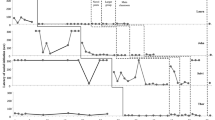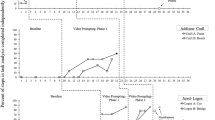Abstract
This study comprised of two experiments was designed to teach complex social sequences to children with autism. Experimental control was achieved by collecting data using means of within-system design methodology. Across a number of conditions children were taken to a room to view one of the four short videos of two people engaging in a simple sequence of activities. Then, each child’s behavior was assessed in the same room. Results showed that this video modeling procedure enhanced the social initiation skills of all children. It also facilitated reciprocal play engagement and imitative responding of a sequence of behaviors, in which social initiation was not included. These behavior changes generalized across peers and maintained after a 1- and 2-month follow-up period.







Similar content being viewed by others
References
Alcantara, P. R. (1994). Effects of videotape instructional package on purchasing skills of children with autism. Exceptional Children, 61(1), 40–55.
American Psychiatric Association (1994). Diagnostic and statistical manual of mental disorders (4th ed.). Washington: American Psychiatric Association.
Baer, D. M., & Deguchi, H. (1985). Generalized imitation from a radical-behavioral viewpoint. In S. Reiss, & R. R. Bootzin (Eds.), Theoretical issues in behavior therapy (pp. 179–217). London: Academic.
Bondy, A., & Frost, L. (2001). A picture’s worth. PECS and other visual communication strategies in autism. Bethesda: Woodbine House.
Bondy, A. S. (1982). Effects of prompting and reinforcement of one response pattern upon imitation of a different modeled pattern. Journal of the Experimental Analysis of Behavior, 37(1), 135–141.
Brady, M. P., McEvoy, M. A., Wehby, J., & Ellis, D. (1987). Using peers as trainers to increase an autistic child’s social interactions. The Exceptional Child, 34(3), 213–219.
Carpenter, M., Pennington, B. F., & Rogers, S. J. (2002). Interrelations among social-cognitive skills in young children with autism. Journal of Autism and Developmental Disorders, 32(2), 91–106.
Catania, A. C. (1997). Learning (4th ed.). Englewood Cliffs: Prentice-Hall.
Chandler, L. K., Lubeck, R. C., & Fowler, S. A. (1992). Generalization and maintenance of preschool children’s social skills: a review and analysis. Journal of Applied Behavior Analysis, 25(2), 415–428.
Charlop, M. H., & Milstein, J. P. (1989). Teaching autistic children conversational speech using video modeling. Journal of Applied Behavior Analysis, 22(3), 275–285.
Charlop-Christy, M. H., & Daneshvar, S. (2003). Using video modeling to teach perspective taking to children with autism. Journal of Positive Behavior Interventions, 5(1), 12–21.
Charlop-Christy, M. H., Le, L., & Freeman, K. A. (2000). A comparison of video modeling with in vivo modeling for teaching children with autism. Journal of Autism and Developmental Disorders, 30(6), 537–552.
Cooper, J. O. (1987). Imitation. In J. O. Cooper, T. E. Heron, & W. L. Heward (Eds.), Applied behavior analysis (pp. 365–376). New York: Macmillan.
D’Ateno, P., Mangiapanello, K., & Taylor, B. A. (2003). Using video modeling to teach complex play sequences to a preschooler with autism. Journal of Positive Behavior Interventions, 5(1), 5–11.
Dauphin, M., Kinney, E. M., & Stromer, R. (2004). Using video-enhanced activity schedules and matrix training to teach sociodramatic play to a child with autism. Journal of Positive Behavior Interventions, 6(4), 238–250.
Duchan, J. (1986). Learning to describe events. Topics in Language Disorders, 6(4), 27–36.
Dunn, J., & McGuire, S. (1992). Sibling and peer relationships in childhood. Journal of Child Psychology and Psychiatry, 33(1), 67–105.
Garfinkle, A. N., & Schwartz, I. S. (2002). Peer imitation: increasing social interactions in children with autism and other developmental disabilities in inclusive preschool classrooms. Topics in Early Childhood Special Education, 22(1), 26–38.
Gena, A., & Kymissis, E. (2001). Assessing and setting goals for the attending and communicative behavior of three preschoolers with autism in inclusive kindergarten settings. Journal of Autism and Developmental Disorders, 13(1), 11–26.
Grant, L., & Evans, A. (1994). Principles of behavior analysis. New York: HarperCollins College.
Haring, T. G., Breen, C. G., Weiner, J., Kennedy, C. H., & Bednersh, F. (1995). Using videotape modeling to facilitate generalized purchasing skills. Journal of Behavioral Education, 5(1), 29–53.
Haring, T. G., Kennedy, C. H., Adams, M. J., & Pitts-Conway, V. (1987). Teaching generalization of purchasing skills across community settings to autistic youth using videotape modeling. Journal of Applied Behavior Analysis, 20(1), 89–96.
Hauck, M., Fein, D., Waterhouse, L., & Feinstein, C. (1995). Social initiations by autistic children to adults and other children. Journal of Autism and Developmental Disorders, 25(6), 579–595.
Heward, W. L. (1987). Multiple baseline and changing criterion designs. In J. O. Cooper, T. E. Heron, & W. L. Heward (Eds.), Applied behavior analysis (pp. 195–226). New York: Macmillan.
Hwang, B., & Hughes, C. (2000). The effects of social interactive training on early social communicative skills of children with autism. Journal of Autism and Developmental Disorders, 30(4), 331–343.
Ihrig, K., & Wolchik, S. A. (1988). Peer versus adult models and autistic children’s learning: acquisition, generalization and maintenance. Journal of Autism and Developmental Disorders, 18(1), 67–79.
Ingersoll, B., Schreibman, L., Stahmer, A. (2001). Brief report: differential treatment outcomes for children with autistic spectrum disorder based on level of peer social avoidance. Journal of Autism and Developmental Disorders, 31(3), 343–349.
Johnston, J. M., & Pennypacker, H. S. (1993). Readings for strategies and tactics of behavioral research. Hillsdale: Lawrence Erlbaum Associates.
Kimball, J. W., Kinney, E. M., Taylor, B. A., & Stromer, R. (2003). Lights, camera, action! Using engaging computer-cued activity schedules. Teaching Exceptional Children, 36(1), 40–45.
Kinney, E. M., Vedora, J., & Stromer, R. (2003). Computer-presented video models to teach generative spelling to a child with an autism spectrum disorder. Journal of Positive Behavior Interventions, 5(1), 22–29.
Koegel, L. K., Camarata, S. M., Valdez-Menchaca, M., & Koegel, R. L. (1998). Setting generalization of question-asking by children with autism. American Journal on Mental Retardation, 102(4), 346–357.
Koegel, L. K., Koegel, R. L., Frea, W. D., & Fredeen, R. M. (2001). Identifying early intervention target for children with autism in inclusive school settings. Behavior Modification, 25(5), 754–761.
Kohler, F. W., & Greenwood, C. R. (1986). Toward a technology of generalization: the identification of natural contingencies of reinforcement. The Behavior Analyst, 9(1), 19–26.
Lord, C., & Pickles, A. (1996). Language level and nonverbal social-communicative behaviors in autistic and language-delayed children. Journal of the American Academy of Child and Adolescent Psychiatry, 35(11), 1542–1550.
MacDuff, G. S., Krantz, P. J., & McClannahan, L. E. (1993). Teaching children with autism to use photographic activity schedules: maintenance and generalization of complex response chains. Journal of Applied Behavior Analysis, 26(1), 89–97.
Martin, G., & Pear, J. (2002). Behavior modification. What it is and how to do it (7th ed.). Upper Saddle River: Prentice-Hall.
Masia, C. L., & Chase, P. N. (1997). Vicarious learning revisited: a contemporary behavior analytic interpretation. Journal of Behavior Therapy and Experimental Psychiatry, 28(1), 41–51.
McClannahan, L. E., & Krantz, P. J. (1999). Activity schedules for children with autism. Teaching independent behavior. Bethesda: Woodbine House.
McDonough, L., Stahmer, A., Schreibman, L., & Thompson, S. J. (1997). Deficits, delays, and distractions: an evaluation of symbolic play and memory in children with autism. Development and Psychopathology, 9(1), 17–41.
McGuigan, S., & Keenan, M. (2002). Rule following in functional equivalence classes. European Journal of Behaviour Analysis, 3(1), 21–29.
Njardvik, U., Matson, J. L., & Cherry, K. E. (1999). A comparison of social skills in adults with autistic disorder, pervasive developmental disorder not otherwise specified, and mental retardation. Journal of Autism and Developmental Disorders, 29(4), 287–295.
Nikopoulos, C. K., & Keenan, M. (2003). Promoting social initiation in children with autism. Behavioral Interventions, 18(2), 87–108.
Nikopoulos, C. K., & Keenan, M. (2004a). Effects of video modeling on social initiations by children with autism. Journal of Applied Behavior Analysis, 37(1), 93–96.
Nikopoulos, C. K., & Keenan, M. (2004b). Effects of video modelling on training and generalisation of social initiation and reciprocal play by children with autism. European Journal of Behaviour Analysis, 5(1), 1–13.
Oke, N. J., & Schreibman, L. (1990). Training social initiations to a high-functioning autistic child: assessment of collateral behavior change and generalization in a case study. Journal of Autism and Developmental Disorders, 20(4), 479–497.
Rincover, A., & Ducharme, J. M. (1987). Variables influencing stimulus overselectivity and “tunnel vision” in developmentally delayed children. American Journal of Mental Deficiency, 91(4), 422–430.
Roeyers, H. (1996). The influence of nonhandicapped peers on the social interactions of children with a pervasive developmental disorder. Journal of Autism and Developmental Disorders, 26(3), 303–320.
Roid, G. H., & Sampers, J. (2004). Merrill-Palmer developmental scale—revised manual. Wood Dale: Stoelting.
Ross, D. E., & Greer, R. D. (2003). Generalized imitation and the mand: inducing first instances of speech in young children with autism. Research in Developmental Disabilities, 24(1), 58–74.
Rutter, M., Mawhood, L., & Howlin, P. (1992). Language delay and social development. In P. Fletcher, & D. Hale (Eds.), Specific speech and language disorders in children. London: Whurr.
Sarafino, E. P. (2001). Behavior modification: principles of behavior change (2nd ed.). New York: McGraw-Hill.
Schopler, E., & Mesibov, G. B. (1986). Social behavior in autism. New York: Plenum.
Schopler, E., Reichler, R., & Renner, B. R. (2002). The Childhood Autism Rating Scale (CARS) for diagnostic screening and classification of autism (9th ed.). New York: Irvington.
Schreibman, L. (2000). Intensive behavioral/psychoeducational treatments for autism: research needs and future directions. Journal of Autism and Developmental Disorders, 30(5), 373–378.
Schreibman, L., Whalen, C., & Stahmer, A. C. (2000). The use of video priming to reduce disruptive transition behavior in children with autism. Journal of Positive Behavior Interventions, 2(1), 3–11.
Sherer, M., Pierce, K. L., Paredes, S., Kisacky, K. L., Ingersoll, B., & Schreibman, L. (2001). Enhancing conversational skills in children with autism via video technology. Which is better, “self” or “other” as a model? Behavior Modification, 25(1), 140–158.
Shipley-Benamou, R., Lutzker, J. R., & Taubman, M. (2002). Teaching daily living skills to children with autism through instructional video modeling. Journal of Positive Behavior Interventions, 4(3), 165–175.
Skinner, B. F. (1957). Verbal behavior. New York: Appleton-Century-Crofts.
Stevenson, C. L., Krantz, P. J., & McClannahan, L. E. (2000). Social interaction skills for children with autism: a script-fading procedure for nonreaders. Behavioral Interventions, 15(1), 1–20.
Stutsman, R. (1948). Merrill-Palmer scale of mental tests. Wood Dale: Stoelting.
Taylor, B. A., Levin, L., & Jasper, S. (1999). Increasing play-related statements in children with autism toward their siblings: effects of video modeling. Journal of Developmental and Physical Disabilities, 11(3), 253–264.
Tissot, C., & Evans, R. (2003). Visual teaching strategies for children with autism. Early Child Development and Care, 173(4), 425–433.
Tryon, A. S., & Keane, S. P. (1986). Promoting imitative play through generalized observational learning in autisticlike children. Journal of Abnormal Child Psychology, 14(4), 537–549.
Wetherby, A. M., Prizant, B. M., & Hutchinson, T. A. (1998). Communicative, social/affective, and symbolic profiles of young children with autism and pervasive developmental disorders. American Journal of Speech-Language Pathology, 7(2), 79–91.
Young, J. M., Krantz, P. J., McClannahan, L. E., & Poulson, C. (1994). Generalized imitation and response-class formation in children with autism. Journal of Applied Behavior Analysis, 27(4), 685–697.
Acknowledgments
We are grateful to the principal, Colm Davis, and to all staff of Tor Bank special school in Dundonald, N. Ireland for their cooperation in conducting this study. A special thanks to all of the children who participated in the study. Also, we appreciate the helpful comments of the reviewers.
Author information
Authors and Affiliations
Corresponding author
Additional information
Portions of this study were presented at the annual conference of the British Psychological Society, Northern Ireland Branch, April 2004.
Rights and permissions
About this article
Cite this article
Nikopoulos, C.K., Keenan, M. Using Video Modeling to Teach Complex Social Sequences to Children with Autism. J Autism Dev Disord 37, 678–693 (2007). https://doi.org/10.1007/s10803-006-0195-x
Published:
Issue Date:
DOI: https://doi.org/10.1007/s10803-006-0195-x




